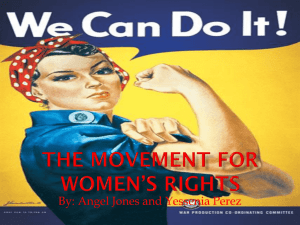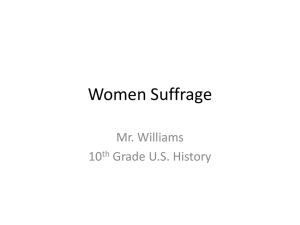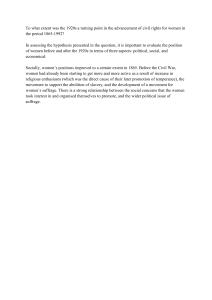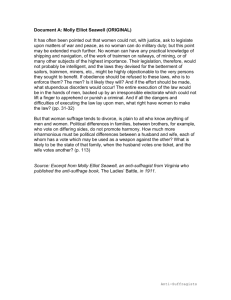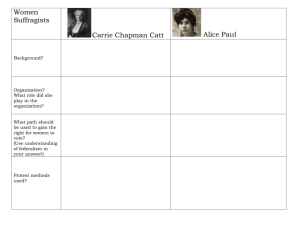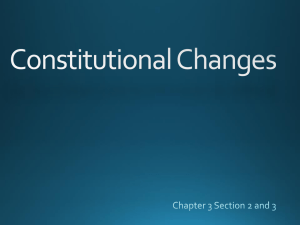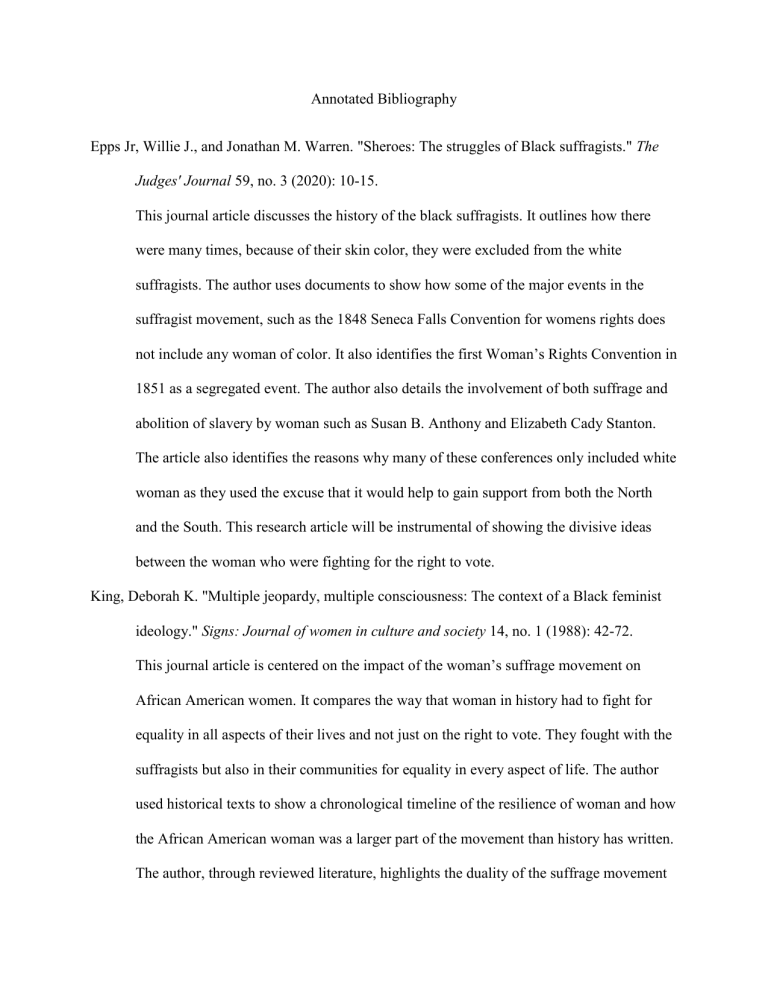
Annotated Bibliography Epps Jr, Willie J., and Jonathan M. Warren. "Sheroes: The struggles of Black suffragists." The Judges' Journal 59, no. 3 (2020): 10-15. This journal article discusses the history of the black suffragists. It outlines how there were many times, because of their skin color, they were excluded from the white suffragists. The author uses documents to show how some of the major events in the suffragist movement, such as the 1848 Seneca Falls Convention for womens rights does not include any woman of color. It also identifies the first Woman’s Rights Convention in 1851 as a segregated event. The author also details the involvement of both suffrage and abolition of slavery by woman such as Susan B. Anthony and Elizabeth Cady Stanton. The article also identifies the reasons why many of these conferences only included white woman as they used the excuse that it would help to gain support from both the North and the South. This research article will be instrumental of showing the divisive ideas between the woman who were fighting for the right to vote. King, Deborah K. "Multiple jeopardy, multiple consciousness: The context of a Black feminist ideology." Signs: Journal of women in culture and society 14, no. 1 (1988): 42-72. This journal article is centered on the impact of the woman’s suffrage movement on African American women. It compares the way that woman in history had to fight for equality in all aspects of their lives and not just on the right to vote. They fought with the suffragists but also in their communities for equality in every aspect of life. The author used historical texts to show a chronological timeline of the resilience of woman and how the African American woman was a larger part of the movement than history has written. The author, through reviewed literature, highlights the duality of the suffrage movement and also shows how this has supported many other equality movements in history. This article will be helpful in my research as it shows two perspectives on the suffrage movement from two groups of people who were not considered equal at the time but built a relationship based on their common goals. McCammon, Holly J., Karen E. Campbell, Ellen M. Granberg, and Christine Mowery. "How movements win: Gendered opportunity structures and US women's suffrage movements, 1866 to 1919." American sociological review (2001): 49-70. This article provides research on many events that happened in the United States before 1919 involving any efforts and wins on the struggle for the womens right to vote. It includes events such as the way women were granted the right to vote in NJ school board elections in the early 1800’s. It also details the initial planning stages of the Seneca Falls convention and how the women found each other who were instrumental in this event. It also identifies other achievements in equality such as the right for some woman to become preachers and other meetings that contributed to the movement. This article will be helpful in the research as it outlines many details that we have not heard about. Some meetings that were held where men were not allowed and others that promoted the movement in areas of the country that were not in favor of it. There were many moving parts to equality in the 1900’s and this article identifies them. Porter, Corinne, and Kathleen Munn. "Forging a Path to the 19th Amendment: Understanding Women's Suffrage." Social Education 83, no. 5 (2019): 248-255. This article details the events and the history that led up to the women’s suffragist movement. It identifies how woman were excluded from all documents dating back to 1787 and remained this way util the time of the ratification of the 19th amendment. The author also provided a history of various other women’s movements which led up to the 100th anniversary of the 19th amendment in the 2020 commemoration. The research also shows the diversity in the events of the struggle which involve any civic engagements during the movement. This includes marches, speeches and even arrests. The author’s main point was to show how there were many moving parts that led to the right to vote. Some of these were small efforts and some involved large scale attempts. This will be helpful for the research as it provides fine details that many people may not write about. It is a comprehensive history of the movement over the past one hundred years. Wheeler, Marjorie Spruill. New Women of the New South: The Leaders of the Woman Suffrage Movement in the Southern States. Oxford University Press, 1993. This book is a secondary source that presents an alternative view of the suffrage movement by viewing it from the perspective of the citizens of the south. It shows how there was a great deal of interference and resistance from the south as it involved the idea of race also. Many did not want African American women to be given the right to vote and wanted them excluded from the movement. There was also a large amount of political corruption when this issue was raised. The author conveys the ideas of eleven suffragist leaders from the South and how each of them impacted the struggle whether positively or negatively. This research will be helpful as it presents opposing views on the movement. It also highlights the discriminatory era and how race was put ahead of suffrage in many cases. Presenting different views on the movement and the subject will enhance the research paper and the argument put forward in it.

